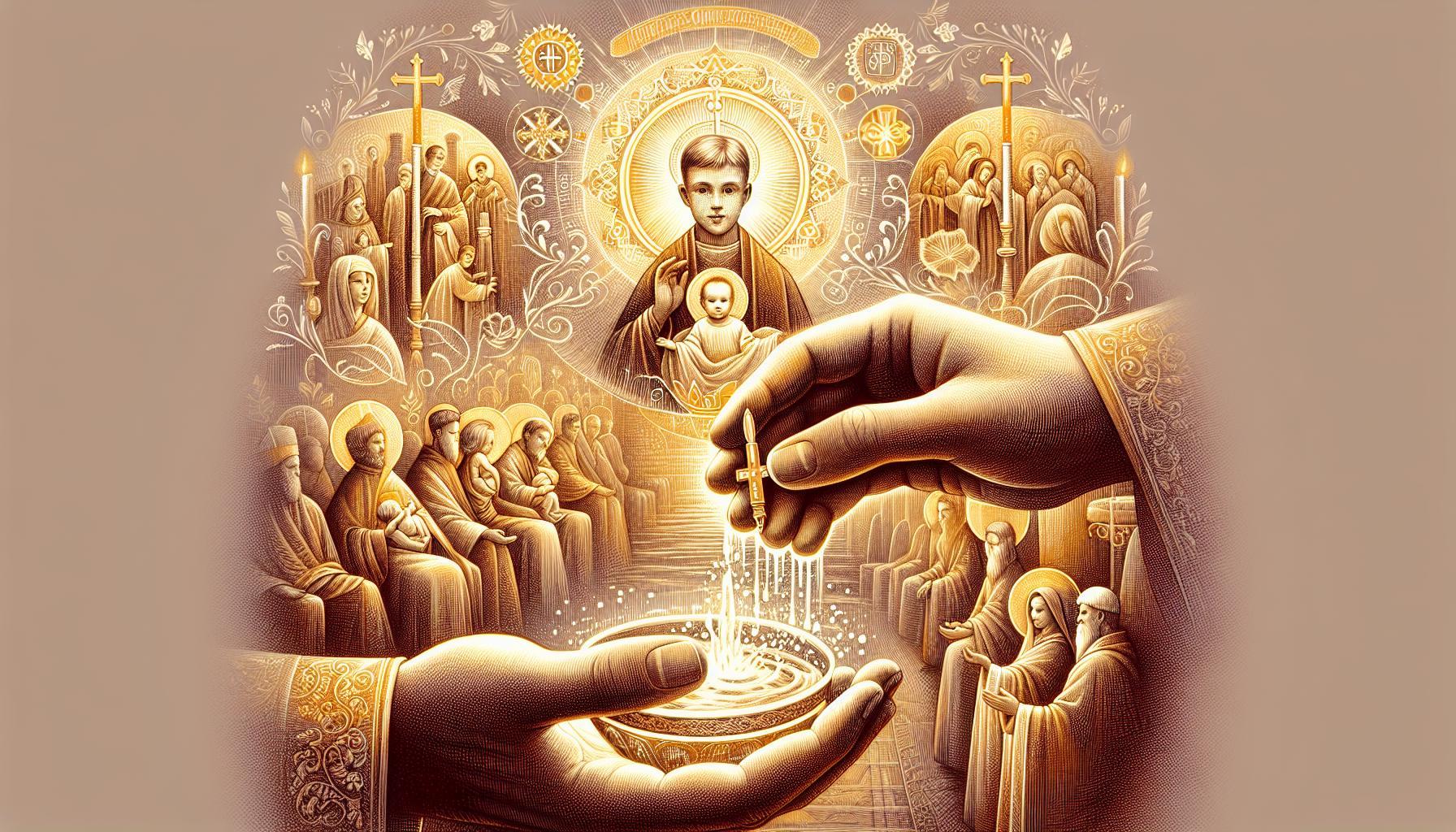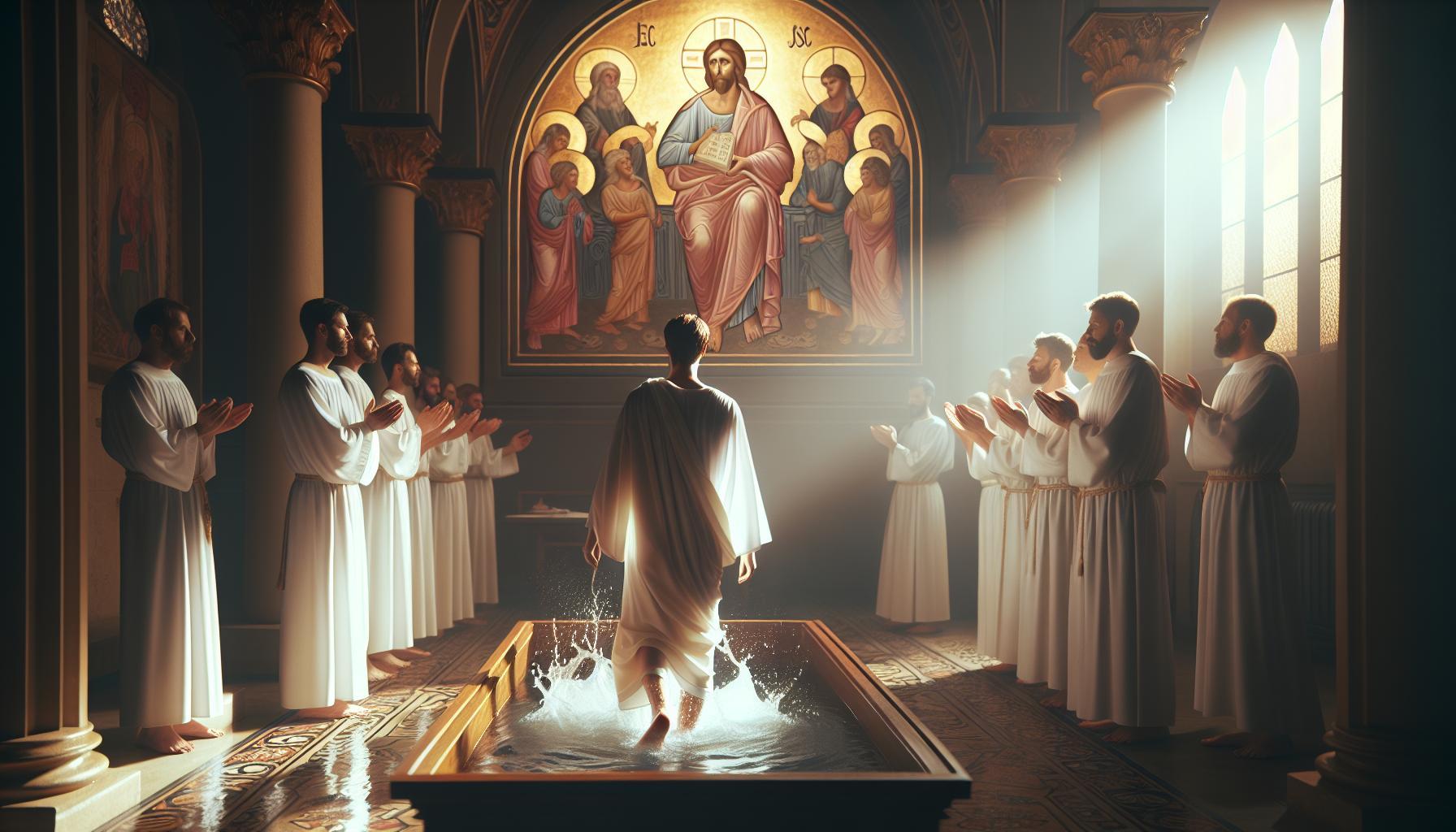When planning a bilingual ceremony, understanding how to express sacred terms like baptism in Spanish is crucial. Not only does this enhance communication, but it also honors cultural traditions. In Spanish, baptism translates to “bautismo” or “bautizo,” providing the foundation for meaningful participation in spiritual celebrations across language barriers.
Understanding the Significance of Baptism in Different Cultures
Baptism serves as a profound act of faith found across various cultures and religions, each interpreting its significance through unique lenses and rituals. This transformative ceremony often symbolizes purification, initiation, and deep commitment to a community or belief system. While rooted predominantly in Christianity, the concept of baptism-like rites can also be found in other traditions, demonstrating the universal value placed on renewal and spiritual awakening.
Christianity’s Emphasis on Baptism
In Christianity, baptism is often viewed as the foundational sacrament that signifies the entry of an individual into the faith. It is typically performed using water, symbolizing the washing away of sins and the rebirth of the individual into a life guided by Christian principles. Different denominations, such as Catholicism, Orthodoxy, and Protestantism, have diverse practices and theological understandings surrounding baptism, but they all acknowledge its importance in marking one’s commitment to Christ. For example, in many Christian families, a child’s baptism is a joyous event, with special ceremonies held to introduce the child to the church community.
Analogous Rites in Other Cultures
While baptism as understood in Christianity may not be present in every culture, similar rituals exist that convey the same themes of purification and initiation. In Hinduism, ceremonies like Namkaran serve a comparable purpose, incorporating prayers for blessings during a naming ceremony shortly after birth. These rites, though not involving water directly, signify significant spiritual transitions for the newborn and their family.
In Islam, although there is no baptism akin to that in Christianity, important practices surrounding birth embrace themes of purification. For instance, the Aqiqah ritual, which involves the ceremonial shaving of a baby’s head and the donation of its weight in silver or gold to charity, emphasizes the introduction of the child into the community and the importance of spiritual cleanliness.
| Religion | Baptism Equivalent | Key Elements |
|---|---|---|
| Christianity | Baptism | Water, community initiation, forgiveness of sins |
| Hinduism | Namkaran | Naming ceremony, blessings, family prayers |
| Islam | Aqiqah | Shaving head, charity donation, birth celebration |
The investigation into these diverse rituals not only underscores the significance of baptism in various cultures but also reveals a shared understanding of the necessity for purification and commitment among different faiths. Exploring terms like “bautismo” in Spanish opens doors to deeper cultural appreciation and understanding, enriching bilingual ceremonies with sacred meanings. When planning multilingual events, incorporating bilingual terminology not only respects cultural backgrounds but also enhances the community’s engagement and inclusivity. Understanding these practices promotes a greater appreciation for the shared values of commitment and spiritual renewal inherent in baptismal traditions around the world.
How to Pronounce “Baptism” and Its Spanish Equivalent

The pronunciation of “baptism” often perplexes language learners and native speakers alike due to its unique phonetic structure. In English, “baptism” is pronounced as /ˈbæp.tɪ.zəm/, where the emphasis is placed on the first syllable. To master the pronunciation, consider breaking it down into its syllabic components:
- Bap – pronounced like “bap,” as in “bath.”
- Tiz – rhymes with “his.”
- Um – sounds like “زم,” a soft, unstressed sound.
Listening to native speakers can greatly enhance pronunciation skills. Both Cambridge Dictionary and YouTube resources provide auditory examples that can aid in learning how to pronounce “baptism” correctly.
Spanish Equivalent: “Bautismo”
In Spanish, the equivalent term for baptism is “bautismo,” pronounced as /bawˈtiz.mo/. Similar to its English counterpart, emphasis is also placed on the first syllable. To articulate “bautismo,” consider the following breakdown:
- Bau – pronounced like “bowl” without the ‘l’.
- Tiz – similar to the English “tiz” in “frizz.”
- Mo – pronounced like “mo” in “mow.”
Understanding the pronunciation of “bautismo” can enhance bilingual ceremonies, making them more accessible and meaningful to participants. Engaging with various media, such as audio recordings or bilingual dictionaries, can provide further practice and confidence in using these sacred terms during religious events. This knowledge not only enriches your vocabulary for ceremonies but also fosters deeper connections within diverse communities.
A Deep Dive into the Spiritual Meaning of “Bautismo”

The concept of baptism, or “bautismo” in Spanish, transcends mere tradition, acting as a profound spiritual milestone in the life of a believer. With roots deeply embedded in Christian doctrine, baptism signifies not only the individual’s identification with Christ and His community but also embodies a transformative rebirth and renewal of faith. This sacred act provides an opportunity for personal reflection and communal commitment, inviting believers to embrace their spiritual journey with clarity and purpose.
The Symbolism of Bautismo
In the context of Christian teachings, baptism serves as a significant marker of an individual’s faith journey. It symbolizes a person’s covenant with God and serves as a public declaration of their commitment to live according to Christian values. Through baptism, believers express their intent to shed old identities and embrace a new life filled with spiritual promise. This act aligns with biblical teachings, such as those found in Ephesians 4:5, which highlights the unity that baptism fosters within the body of Christ—”one Lord, one faith, one baptism”[[2](https://www.christianity.com/wiki/christian-terms/what-does-baptism-mean.html)].
Additionally, baptism is a cultural bridge in bilingual ceremonies, reflecting a rich tapestry of diverse faith expressions among communities. It is crucial for individuals participating in such ceremonies to appreciate the deeper meanings behind “bautismo.” This understanding can enhance their personal spiritual experiences while promoting a deeper connection with fellow believers.
- Rebirth: Represents a fresh start and renewal of the believer’s life.
- Identity: Affirms one’s identity as a member of the Christian community.
- Obedience: Acts as a fulfillment of Christ’s command to make disciples.
- Community Connection: Strengthens ties within the church family, fostering a sense of belonging.
Understanding the spiritual depth of bautismo is essential for believers participating in bilingual ceremonies. As they navigate their faith in diverse environments, the incorporation of rituals such as baptism allows them to honor their heritage while simultaneously affirming their commitment to their beliefs. Engaging in discussions about the significance and implications of baptism can empower individuals to embrace this sacred term fully, making it a pivotal moment in their spiritual lives.
Key Biblical References: Baptism Across Translations

Understanding the nuances of baptism is essential for anyone seeking to convey its significance across different languages and cultures. The act of baptism, steeped in religious tradition, appears in various biblical references and is often subject to intricate translations. In examining the term “baptism” in English versus its Spanish equivalent, “bautismo,” we can appreciate the deeper meanings and variations that arise in different contexts.
Biblical references to baptism highlight its multifaceted significance. The Greek word used in the New Testament, “βαπτίζω” (baptizo), indicates immersion, signifying a transformative act that encompasses repentance and renewal. When looking at how to say baptism in Spanish, utilizing “bautismo” aligns closely with its original meaning yet resonates differently within Hispanic communities. This shift evidence the culture’s interpretation of spiritual rites.
It is worth noting that several biblical passages underscore the importance of baptism, often seen as a rite of initiation into faith. Key verses like Matthew 28:19 and Acts 2:38 call for baptism as a public declaration of faith, enhancing its relevance in both English and Spanish-speaking congregations. In bilingual ceremonies, it may be beneficial to explain this sacramental act further, ensuring that participants comprehend its significance, regardless of their linguistic background.
To facilitate understanding in multilingual settings, engage with participants by exploring:
- Scriptural Foundations: Review key verses in both languages to foster a unified understanding.
- Cultural Context: Discuss how baptism is perceived within local traditions and customs, highlighting unique ceremonies that may accompany it.
- Language Nuances: Provide examples of how “bautismo” may vary in meaning across different Spanish-speaking countries while maintaining its biblical roots.
This approach not only enriches the ceremony but also cultivates a deeper appreciation for the sacred act of baptism, bridging gaps between languages and traditions. Such an effort underscores the importance of understanding how to say baptism in Spanish and the role it plays in diverse cultural expressions of faith.
Preparing for a Bilingual Baptism Ceremony: Tips and Insights
Preparing for a bilingual baptism ceremony opens doors to profound connections and shared experiences among diverse congregations. The incorporation of two languages not only enhances inclusivity but also enriches the spiritual significance of the event. Whether you are a minister or a family member involved in planning, understanding the unique aspects of this celebration is essential for ensuring that everyone feels welcomed and engaged in the ritual.
Key Elements to Consider
To create a memorable bilingual baptism ceremony, consider the following aspects:
- Language Preparation: Familiarize yourself with key phrases and terminology. Knowing how to say “baptism” in Spanish (“bautismo”) and other essential spiritual terms can help bridge communication gaps.
- Cultural Sensitivity: Acknowledge cultural differences in the significance of baptism. Incorporate elements from both traditions, such as songs or prayers, for a richer experience.
- Visual Aids: Use visuals like bilingual programs or slides during the ceremony. This ensures everyone can follow along, regardless of their primary language.
- Involvement of the Congregation: Encourage participation from both English and Spanish-speaking members through readings or testimonies. This fosters a sense of unity and community.
Add a Personal Touch
Real-life stories can enhance the baptism experience. Facilitate sharing of personal testimonies in both languages, capturing the heartfelt moments leading to this significant step in one’s faith journey. Providing a warm, inviting atmosphere where individuals can express their beliefs also promotes deeper connections among attendees.
Bilingual Ceremony Example Table
| English | Spanish |
|---|---|
| Welcome to the baptism of… | Bienvenido al bautismo de… |
| May you grow in faith and love. | Que crezcas en fe y amor. |
| We now baptize you in the name of the Father… | Ahora te bautizamos en el nombre del Padre… |
Incorporating these considerations can lead to an enriching bilingual baptism ceremony. Remember that the primary goal is to celebrate faith and community, allowing everyone to feel a part of the sacred experience, emphasizing the importance of how to say baptism in Spanish as a vital step towards inclusivity.
Incorporating Traditions and Customs in Spanish-Speaking Contexts
In the vibrant tapestry of Spanish-speaking cultures, the integration of traditions and customs into significant life events, such as baptisms, holds immense importance. By weaving cultural elements into bilingual ceremonies, families not only honor their heritage but also create a richer, more meaningful experience. Understanding how to say baptism in Spanish—“bautismo”—is just the starting point in embracing this cultural fusion.
One effective way to incorporate traditions into a baptism ceremony is by including meaningful rituals common within Spanish-speaking communities. For example, during the ceremony, families can involve godparents, known as padrinos and madrinas, highlighting their crucial role in the child’s spiritual upbringing. Additionally, incorporating specific prayers and blessings in both Spanish and English can enhance the sacred atmosphere, making the event inclusive for all attendees.
Celebratory Elements and Cultural Touches
Integrating festive elements from Spanish traditions can elevate the baptism experience. Consider the following ideas:
- Candle Lighting: Use beautifully decorated candles, often a symbol of Christ being the light of the world.
- Traditional Music: Incorporate Spanish hymns or flamenco music during the celebrations to reflect cultural pride.
- Reception Features: Serve traditional dishes like tortilla española or croquetas at the baptism reception, allowing guests to indulge in the culinary richness of Spanish culture.
It is also essential to create programs that outline the ceremony in both languages, ensuring clarity and engagement for all participants. This can include translation for key phrases or prayers, making it easier for everyone to follow along and fully participate in the sacred event.
When planning a bilingual baptism, a well-structured approach to incorporating traditions will ensure that both the spiritual significance and the rich cultural practices are honored, creating an atmosphere where family, faith, and heritage converge beautifully. By embracing such multifaceted traditions, families can truly celebrate the momentous occasion in a way that resonates deeply across generations.
Exploring the Role of Godparents in Baptism: Cultural Variations
In many cultures, the role of godparents during baptism is more than just a formal obligation; it carries profound spiritual and social significance. This special relationship often shapes the faith and moral foundations of the child, creating a lasting bond that transcends religious duties. Exploring these variations sheds light on how traditions around godparenting can differ significantly across cultures, especially in bilingual communities where the customs might intersect.
In Hispanic cultures, for instance, godparents, known as “padrinos” and “madrinas,” hold a revered status. They are expected to play an active role in the child’s spiritual upbringing, often being involved in milestone events beyond baptism, such as first communions and confirmations. This expectation emphasizes the godparent’s duty to guide their godchild not only in religious matters but also in personal development. Families often choose godparents based on deep personal connections, further strengthening the ties that bind them to the child.
In contrast, some cultures may adopt a less interactive role for godparents, focusing primarily on their symbolic presence during baptism. For example, in certain European traditions, the responsibilities of godparents can lean more towards ceremonial participation, such as standing as witnesses during the sacrament. Here, the emphasis may lie in upholding family legacy and ensuring the child’s connection to cultural heritage rather than an ongoing mentorship role.
Regardless of cultural distinctions, the core idea remains that godparents are entrusted with a sacred duty. This role is ideally a blend of spiritual guidance and supportive friendship, ensuring the child’s growth in faith and character. It’s important for parents to communicate these expectations clearly when selecting godparents, especially in multicultural environments, to ensure alignment of values and practices that enrich the child’s life journey.
In conclusion, understanding these cultural variations provides insights not only into the roles of godparents but also into the rituals of baptism itself. For bilingual families aiming to celebrate these traditions effectively, knowing how to express key baptismal terms in both languages is essential. This knowledge serves as a bridge, enriching the spiritual experience for families celebrating bilingual ceremonies.
Navigating Language Barriers During Multilingual Ceremonies
Navigating language barriers in multilingual ceremonies, particularly during significant events such as baptisms, requires thoughtful planning and execution to ensure all attendees feel included and engaged. Language is not just a means of communication; it carries cultural significance and emotional weight. For events where participants speak different languages, such as English and Spanish, understanding how to incorporate sacred terms appropriately becomes crucial. Knowing how to say “baptism” in Spanish, for instance, is essential, but the broader context must also address the feelings, traditions, and expressions linked to this rite of passage.
A successful multilingual ceremony can be achieved through several strategies:
- Incorporate Bilingual Programs: Distributing programs that include both languages can help attendees follow along. Ensure that all key terms, such as how to say “baptism” in Spanish—“bautismo”—are highlighted, accompanied by explanations.
- Utilize Technology: Live translation apps and devices can facilitate real-time communication. Encourage speakers to use them, thus allowing non-native speakers to fully grasp the ceremony’s significance.
- Hire Professional Interpreters: Having interpreters available can enhance understanding and respect for cultural nuances. They can convey not just words but also the emotions behind rituals.
To optimize the experience further, consider the layout and flow of the ceremony. For example, alternating between languages during key moments helps to create a rhythm that acknowledges all participants’ linguistic backgrounds. This approach fosters a sense of unity and respect for diversity.
In addition, fostering a pre-ceremony gathering that allows for casual interaction among guests can break down initial barriers. Educational sessions explaining cultural significance and sacred terms deepen understanding—teaching attendees about “bautismo” and its essence in various traditions can enhance the overall experience.
Implementing these techniques not only improves communication but also enriches the spiritual and communal experience of the ceremony, creating unforgettable memories for all participants.
Frequently Asked Questions
How to say baptism in Spanish?
The word for baptism in Spanish is bautismo. This term is widely used in both religious and cultural contexts within Spanish-speaking communities.
Baptism, or bautismo, signifies a sacred initiation into the Christian faith. In many traditions, this sacrament involves the use of water, symbolizing purification. Understanding this term enhances participation in bilingual ceremonies, making it accessible to both English and Spanish speakers.
Why does baptism matter in both languages?
Baptism’s significance transcends language; it represents faith initiation. Knowing how to express these concepts in Spanish enriches the spiritual experience for bilingual congregations.
The act of baptism is a foundational moment in Christianity, marking a person’s commitment to their faith. By using both Spanish and English terms, communities foster inclusivity and understanding during rituals, allowing greater participation from all members.
Can I find baptism resources in Spanish?
Yes, there are many resources available in Spanish regarding baptism. For example, the U.S. Conference of Catholic Bishops offers a baptism handout in Spanish.
What should parents know about baptism in Spanish-speaking contexts?
Parents should be aware of the requirements for baptism, including attending preparation classes. In many parishes, these sessions are conducted in Spanish to assist families.
Understanding the local customs and language is vital. For example, at St. Hugh of Lincoln, parents and godparents must attend a baptism preparation class before the ceremony, ensuring everyone involved is well-prepared.
How to share baptismal promises in Spanish?
Renewing baptismal promises in Spanish can enhance a community’s spiritual engagement. This is a powerful practice often observed during significant liturgical events.
For example, during the Feast of the Baptism of the Lord, congregations can participate in ceremonies that reaffirm their faith and commitment. Understanding how to express these promises in Spanish can create a deeper connection among diverse worshipers.
What differences exist between baptism in Catholic and Protestant traditions?
There are notable differences in baptism practices between Catholic and Protestant traditions, particularly in the age of baptism and the specific rituals performed.
In Catholicism, baptism is often performed on infants, emphasizing original sin’s cleansing. In contrast, many Protestant denominations baptize individuals based on personal faith decisions, which may occur later in life. Understanding these distinctions in both languages fosters respectful dialogues in bilingual communities.
Why should I learn about baptismal terminology in Spanish?
Learning baptismal terminology in Spanish enhances your engagement in bilingual ceremonies. It allows for a more profound appreciation of the rituals and enhances participation.
This knowledge can also support intercultural communication and understanding within diverse congregations. By embracing terms like *bautismo*, individuals can help others feel welcomed and included in their faith journeys.
Wrapping Up
In conclusion, understanding how to say “baptism” in Spanish, whether as “bautismo” or “bautizo,” enriches our appreciation of this sacred rite across cultures. As we engage in bilingual ceremonies, we create a space that honors diverse traditions while fostering a shared spiritual experience. We encourage readers to explore these terms further, reflect on their meanings, and consider how language shapes our understanding of these profound rituals. By embracing both theological depth and practical application, we can unite communities through the sacred act of baptism, offering insights that resonate with all believers. Continue to seek knowledge and share experiences as we collectively honor the significance of baptism in our journeys of faith.





